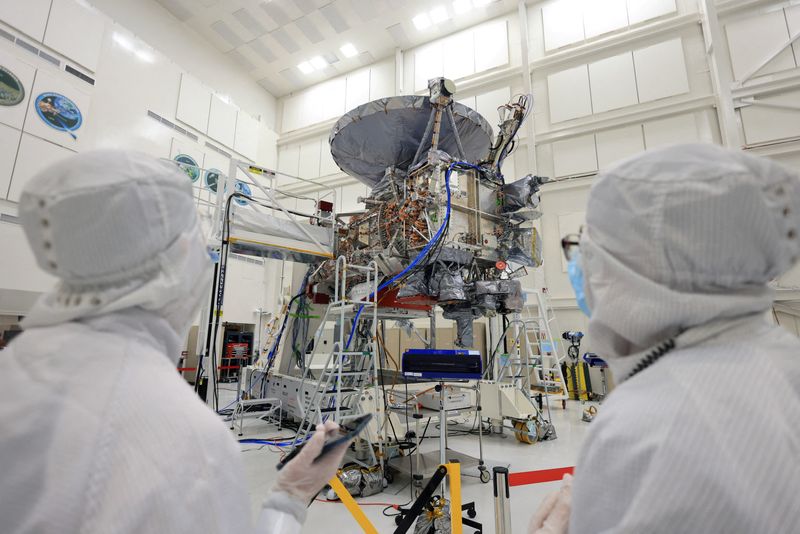By Will Dunham
WASHINGTON (Reuters) – NASA is ready to launch a spacecraft to Jupiter’s moon Europa, thought-about one among our photo voltaic system’s most promising spots to seek for life past Earth, to be taught whether or not this ice-encased world believed to harbor an enormous underground ocean is liveable.
The U.S. house company’s robotic solar-powered Europa Clipper spacecraft will likely be launched on a SpaceX Falcon Heavy rocket from the Kennedy Area Heart in Cape Canaveral, carrying 9 scientific devices. After touring 1.8 billion miles (2.9 billion km) in a visit lasting about 5-1/2 years, Europa Clipper is because of enter orbit round Jupiter in 2030.
After a delay attributable to Hurricane Milton, NASA set a tentative launch time for 12:06 p.m. ET (1606 GMT) on Monday.
Scientists have a eager curiosity within the salty liquid water ocean that earlier observations have indicated resides under Europa’s icy shell.
“There is very strong evidence that the ingredients for life exist on Europa. But we have to go there to find out,” mentioned planetary scientist Bonnie Buratti of NASA’s Jet Propulsion Laboratory, the mission’s deputy challenge scientist.
“Just to emphasize: we’re not a life-detection mission. We’re just looking for the conditions for life,” Buratti added.
Europa Clipper is the largest spacecraft NASA has ever constructed for a planetary mission, measuring about 100 ft (30.5 meters) lengthy, about 58 ft (17.6 meters) broad and weighing roughly 13,000 kilos (6,000 kg). It’s bigger than a basketball courtroom due to its sizable photo voltaic arrays to assemble daylight for powering scientific devices, electronics and its different subsystems.
The spacecraft is because of fly by Mars, then again by Earth, utilizing the gravity of every planet to extend its momentum like a slingshot. It has three important science targets: gauging the thickness of Europa’s outer layer of ice and its interactions with the subsurface under, determining the moon’s composition, and figuring out its geology.
NASA is planning for its spacecraft to conduct 49 shut flybys of Europa over a span of three years.
Europa’s diameter is about 1,940 miles (3,100 km) at its equator, roughly 90% that of our moon. Europa’s icy shell is at the moment believed to be 10-15 miles (15-25 km) thick, floating atop an ocean 40-100 miles (60-150 km) deep.
AN OCEAN WORLD
This moon is taken into account an “ocean world.” Despite the fact that Europa is only a quarter of Earth’s diameter, its subsurface ocean could include twice the water in Earth’s oceans.
“As an ocean world, Europa is very intriguing. And this mission is going to help us to understand a complex piece of our solar system,” mentioned Gina DiBraccio, appearing director of NASA’s planetary science division.
Ocean worlds, DiBraccio mentioned, is perhaps a standard kind of physique exterior our photo voltaic system.
“Clipper is going to be the first in-depth mission that will allow us to characterize habitability on what could be the most common type of inhabited world in our universe,” DiBraccio mentioned.
Regardless of its hostile and frigid floor, scientists consider Europa might be able to nurturing life. Buratti famous that there are three important necessities for all times to kind: liquid water, sure chemistry – particularly natural compounds that would function meals for any primitive organisms – and an power supply.
Europa receives solely about 4% of the photo voltaic radiation that Earth – 5 occasions nearer to the solar – will get. However Buratti famous that Europa flexes as its orbit comes nearer and farther from Jupiter, due to the massive planet’s sturdy gravitational pull – a course of that produces warmth on the moon.
“That’s the source of energy we have,” Buratti mentioned.
On the backside of Europa’s ocean, the place the water meets the rocky mantle, there could also be thermal vents the place warmth releases chemical power.
“They may be similar to thermal vents in the deep oceans of the Earth where primitive life exists and where life may have originated on the Earth,” Buratti mentioned.
The spacecraft’s MASPEX instrument will pattern gases to check Europa’s ocean, floor and atmospheric chemistries. MASPEX will search for “sophisticated organic molecules that could provide the food, if there are any primitive organisms,” Buratti added.
Jupiter is our photo voltaic system’s largest planet. Amongst its 95 formally acknowledged moons, Europa is fourth largest, behind Ganymede, Callisto and Io. Europa orbits about 417,000 miles (671,000 km) from Jupiter.

Buratti mentioned exploratory missions like this one all the time uncover one thing “that we could not have imagined.”
“There is going to be something there – the unknown – that is going to be so wonderful that we can’t conceive of it right now,” Buratti mentioned. “That’s the thing that excites me most.”




